Notre Dame de Paris, one of the most iconic symbols of French Gothic architecture, has stood proudly on the Île de la Cité in the heart of Paris for over eight centuries. Its history is intertwined with the rich tapestry of French culture, witnessing centuries of political, social, and religious transformations.
The devastating fire on 15 April 2019 brought this architectural masterpiece to the brink of destruction, but the subsequent efforts to restore and reopen Notre Dame serve as a testament to human resilience and determination. Words and Photos © Mark Anning 2022
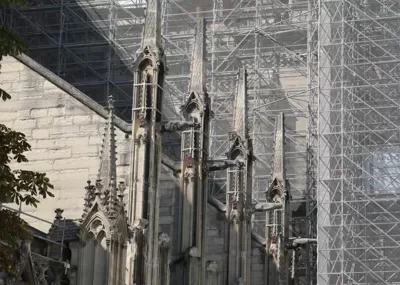


Historical Significance
The construction of Notre Dame began in 1163 during the reign of King Louis VII, and it took nearly 200 years to complete.
The cathedral stands as a prime example of French Gothic architecture, with its impressive flying buttresses, intricate stained glass windows, and the famous gargoyles adorning its façade.
Over the centuries, Notre Dame played a central role in various historical events, including coronations, weddings, and religious ceremonies. It survived the French Revolution, serving as a Temple of Reason, and bore witness to both the triumphs and tribulations of the French people.
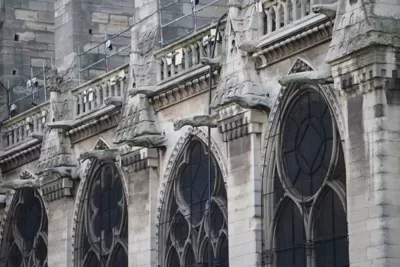

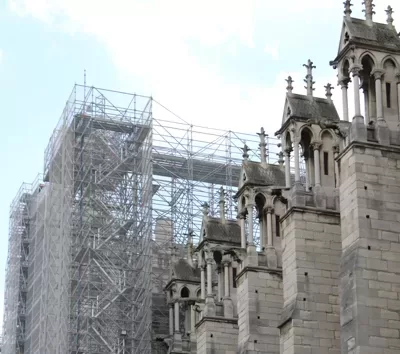

The Devastating Fire
On the fateful evening of April 15, 2019, a fire broke out in the attic of Notre Dame, engulfing the cathedral in flames. The world watched in horror as the iconic spire collapsed, and it seemed that centuries of history were being reduced to ashes. The fire not only posed a threat to a cultural and religious landmark but also stirred a collective sense of loss and mourning.
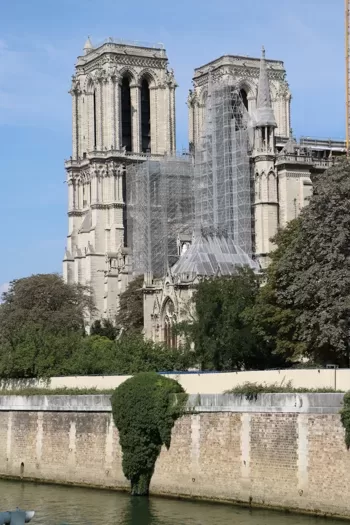

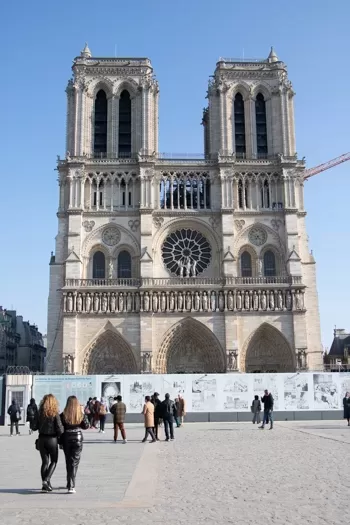

The fire that engulfed Notre Dame de Paris on 15 April 2019, was a catastrophic event that captured the attention of the world and left an indelible mark on the history of this iconic cathedral.
Discovery and Spread of the Fire: The fire was first reported in the early evening, and it quickly spread through the attic of the cathedral. The attic, also known as “the forest” due to its wooden frame, contained ancient timbers, some of which dated back to the 13th century. The dry and aged wood fueled the flames, intensifying the inferno.
Collapse of the Spire: One of the most heart-wrenching moments of the fire was the collapse of the spire. The spire, a 19th-century addition by architect Eugène Viollet-le-Duc, succumbed to the intense heat and eventually crumbled into the burning inferno. The loss of the spire was a symbolic blow, as it had become an integral part of the cathedral’s silhouette.
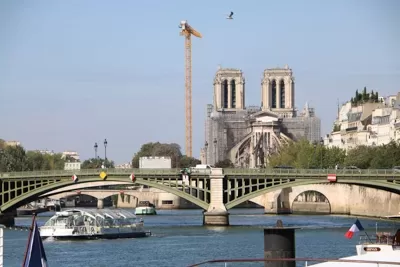

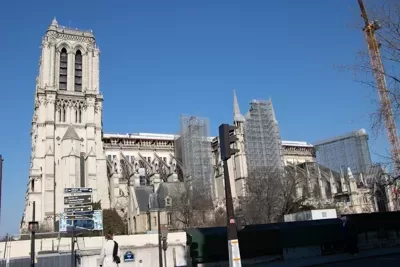

Efforts to Save Artifacts and Relics: As the fire raged, efforts were made to save priceless artifacts and religious relics housed within the cathedral. The Crown of Thorns, believed to be the one worn by Jesus Christ during the crucifixion, and other sacred items were successfully rescued by firefighters and the emergency services. The evacuation of these precious artifacts was a small but significant victory amid the devastation.
Global Response: News of the Notre Dame fire spread rapidly, triggering a global outpouring of grief and support. Political leaders, cultural figures, and ordinary citizens expressed their solidarity with France and its cultural heritage. Donations flooded in from around the world, with individuals, corporations, and governments pledging funds for the restoration effort. The sense of shared loss underscored the universal significance of Notre Dame as a cultural treasure.


Firefighting Challenges: The firefighters faced numerous challenges in battling the blaze. The complex structure of Notre Dame, with its wooden roof and labyrinthine attic, made it difficult to contain the fire.
The intense heat and the risk of structural collapse posed additional challenges, requiring a delicate balance between aggressive firefighting and preservation efforts.
Investigation and Cause: Following the fire, an extensive investigation was launched to determine its cause. Initial findings pointed to an electrical short circuit as a possible ignition source, though the investigation was ongoing. The incident prompted a reassessment of fire safety measures for historic structures across France and beyond.
In the aftermath of the fire, Notre Dame became a symbol not only of loss but also of resilience and the determination to rebuild. The restoration efforts, marked by international collaboration and cutting-edge technology, stand as a testament to the enduring value placed on cultural heritage and the commitment to preserving it for future generations.
The Immediate Response
In the wake of the fire, an outpouring of grief and solidarity emerged not only from the people of France but from around the globe. Political leaders, cultural figures, and ordinary citizens pledged their support for the reconstruction efforts. Within days, millions of euros were donated for the restoration, and experts from various fields joined forces to assess the damage and formulate a plan for rebuilding.
The Restoration Process
The restoration of Notre Dame de Paris presented an unprecedented challenge. The delicate task of rebuilding a structure with centuries-old craftsmanship required a delicate balance between preserving the original design and incorporating modern technologies.



Skilled artisans, architects, and craftsmen worked tirelessly to restore damaged sculptures, rebuild the spire, and repair the structural integrity of the cathedral.
The restoration process also incorporated 3D modeling and cutting-edge technologies to recreate the intricate details of the Notre Dame that once stood proudly.
The Reopening
After years of meticulous restoration work, Notre Dame de Paris is set to reopened its doors to the public on December 8, 2024 — five years and seven months after the devastating fire. The reopening will be a momentous occasion, symbolizing the resilience of the human spirit and the enduring legacy of cultural heritage.


Visitors from around the world are expected to flock to witness the rebirth of this architectural marvel, with Notre Dame once again becoming a symbol of hope, perseverance, and unity.
The history of Notre Dame de Paris is a tale of resilience, from its construction in the 12th century to the devastating fire in 2019 and its triumphant reopening in 2024.
The cathedral’s journey reflects not only the enduring spirit of the French people but also the global community’s commitment to preserving cultural heritage.
Notre Dame de Paris stands as a living testament to the power of human determination and collaboration, ensuring that its legacy will continue to inspire generations to come.


More info on the Notre Dame de Paris website.
Related stories
L’Arc de Triomphe, Wrapped: A Vision in Silvery Blue
“Paris is always a good idea” & other quotes about Paris
Parisian Street Art in Support of Ukraine
Jane Birkin: Inspiration for the most valuable handbag
Luxurious Elegance: Hermés Handbags
French wine lovers love Montmartre Grape Harvest Festival
Speos Magnum documentary & AFP photojournalism courses
Covid anti-vaccine pass sanitaire Paris protest
The Paris Commune: Echoes of Revolution in Belleville
The artists from Belleville, Gainsbourg & Piaf
We are affiliated with and can recommend Paris Sightseeing Tours with Paris CityVision for day tours through Paris and surrounds.
It is free to comment below. Our pied a terre in Belleville is central to our study of the arts in Paris.





